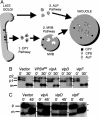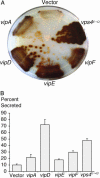Pathogen effector protein screening in yeast identifies Legionella factors that interfere with membrane trafficking
- PMID: 15781869
- PMCID: PMC555709
- DOI: 10.1073/pnas.0501315102
Pathogen effector protein screening in yeast identifies Legionella factors that interfere with membrane trafficking
Abstract
Legionella pneumophila invades and replicates intracellularly in human and protozoan hosts. The bacteria use the Icm/Dot type IVB secretion system to translocate effectors that inhibit phagosome maturation and modulate host vesicle trafficking pathways. To understand how L. pneumophila modulates organelle trafficking in host cells, we carried out pathogen effector protein screening in yeast, identifying L. pneumophila genes that produced membrane trafficking [vacuole protein sorting (VPS)] defects in yeast. We identified four L. pneumophila DNA fragments that perturb sorting of vacuolar proteins. Three encode ORFs of unknown function that are translocated via the Icm/Dot transporter from Legionella into macrophages. VPS inhibitor protein (Vip) A is a coiled-coil protein, VipD is a patatin domain-containing protein, and VipF contains an acetyltransferase domain. Processing studies in yeast indicate that VipA, VipD, and VipF inhibit lysosomal protein trafficking by different mechanisms; overexpressing VipA has an effect on carboxypeptidase Y trafficking, whereas VipD interferes with multivesicular body formation at the late endosome and endoplasmic reticulum-to-Golgi body transport. Such differences highlight the multiple strategies L. pneumophila effectors use to subvert host trafficking processes. Using yeast as an effector gene discovery tool allows for a powerful, genetic approach to both the identification of virulence factors and the study of their function.
Figures




References
Publication types
MeSH terms
Substances
Associated data
- Actions
- Actions
- Actions
- Actions
Grants and funding
LinkOut - more resources
Full Text Sources
Other Literature Sources
Molecular Biology Databases

